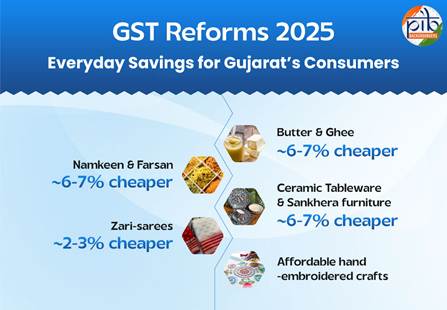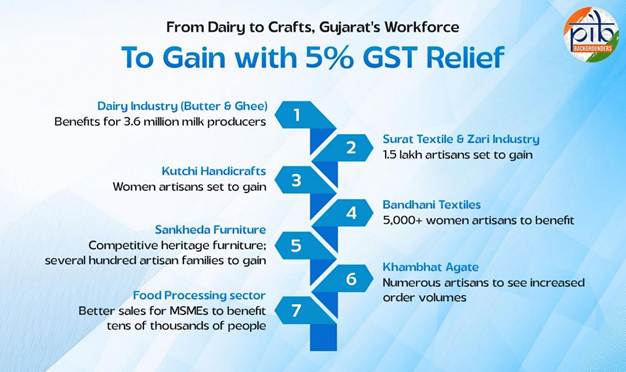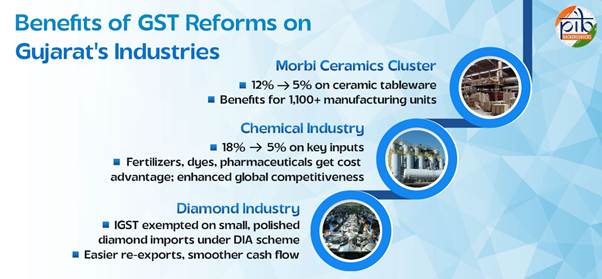Economy
GST Reforms 2025: How Gujarat’s Economy Will Gain Across Sectors
Posted On:
06 OCT 2025 12:17 AM
Key Takeaways
- 5% GST on butter and ghee to makes staples ~6-7% cheaper
- Surat’s zari industry gains with GST reduction, benefitting 1.50 lakh workers
- Traditional textiles & handicrafts such as Kutchi embroidery and Sankheda furniture to be more affordable under 5% GST
- Reduced rates on chemical inputs, ceramics and agate to improve global competitiveness
- IGST relief for diamonds to benefit MSMEs and enhance Surat's position as a global trading hub
|
Introduction

The recent GST reforms are expected to carry major implications for Gujarat, a state whose economy is built on a blend of manufacturing, industrial production, agriculture and allied sectors like dairy, traditional crafts, and global exports. By lowering rates on essential goods and heritage products, while extending relief to industrial inputs and trade facilitation measures, these reforms are expected to give a big boost to the state’s economy.
The reforms span across sectors, benefiting both rural artisans and large industries. They are set to uplift millions of livelihoods, preserve traditional crafts, and drive industrial expansion. At the same time, they will also ease household budgets by lowering consumer prices and improving affordability.
Dairy Value Chain
For Gujarat, where dairy cooperatives form the backbone of the rural economy, the GST reforms are especially impactful. The state is a leading milk-producing state, contributing about 7.7% of India's total milk production. The Gujarat Cooperative Milk Marketing Federation (GCMMF), owner of the Amul brand, is a network of 18 member unions, procuring milk from approximately 3.6 million milk producers. The entire value chain supports livelihoods for millions more.
The reduction of GST on butter and ghee from 12% to 5% is expected to bring major relief for Gujarat’s dairy value chain. The revised rates translate into an immediate price drop of ~6-7%. For instance, a 1 kg pack of ghee that previously cost ₹700 could now be cheaper by ₹40-₹45. By lowering the tax burden, the GST change will boost household savings and consumption.
Textiles & Handicrafts
Surat Textile and Zari Industry
Surat, often celebrated as the “Manchester of India”, stands at the heart of Gujarat’s textile economy with Navsari and Palsana also serving as key clusters. The recent reduction of GST on zari borders from 12% to 5% brings relief to the weavers, dyers, designers, and traders who form the workforce of the industry. Within Surat’s zari industry, around 125,000 to 150,000 people are directly involved, with about 70% being women who operate machines from their homes. Surat produces nearly 40% of India’s man-made fabric, and accounts for about 18% of the nation’s total exports to markets such as the USA, UK, and Italy.
The new GST rate trims embellishment costs, reducing the price of a moderately embellished saree by ~2-3%. This will increase competitiveness and boost sales for weavers.
Kutchi Handicrafts
The handicrafts of Kutch, especially embroidery items and shawls, have received a fresh push with the reduction of GST from 12% to 5%. Centred in villages around Bhuj, Anjar, and Hodka, as well as parts of Jamnagar and Rajkot, the industry is primarily carried forward by women artisans from regional communities. For these households, embroidery is more than an art form; it is a vital source of supplementary income.
Kutch embroidery, renowned for its intricate mirror work and vibrant threads, enjoys strong demand both within India and overseas. Used in apparel, home furnishings, and accessories, the craft also carries a GI tag, marking its origin and heritage value. It has carved out a niche among urban consumers and tourists, with products sold through emporiums, exhibitions, and increasingly on online platforms. Internationally, these handicrafts are exported to the USA, UK, France, and the UAE.
The GST cut improves consumer affordability of handmade products. For instance, a hand-embroidered shawl priced at ₹3,500 now sees its tax fall from ₹420 to ₹175, a saving of ₹245.
Bandhani (Tie-Dye) Textiles
Bandhani, Gujarat’s iconic tie-dye textile, finds its strongest roots in Kutch and Jamnagar, its two most important centres of production. Bandhani is a labor-intensive process, practiced primarily by regional communities, with artisans, especially women, who are skilled in the intricate tying process. The industry sustains thousands of livelihoods, with the Saurashtra region providing employment to over 5,000 artisans.
These textiles hold deep cultural significance, forming an essential part of wedding trousseaus and festive wear in Gujarat and across India. Beyond the domestic market, more than 70% of production from hubs like Jamnagar are sold outside Gujarat to other Indian states, while a portion also reaching international buyers in countries with a large Indian diaspora.

The increase in the threshold for the 5% GST slab to Rs. 2500, makes most mid-range sarees and dupattas affordable for consumers and ensuring steady sales volumes. This will support the livelihood of the artisans who depend on high-volume sales of these items.
Sankheda Wooden Lacquerware Furniture
In the town of Sankheda, located in Chhota Udaipur district, the traditional handcrafted wooden lacquerware continues to define the region’s cultural and economic life. This GI-tagged craft is practiced by artisan families who have passed down these skills through generations. The craft supports several hundred artisan families in and around Sankheda, providing them with a primary livelihood, blending heritage with economic sustenance.
Known for its brightly coloured designs and polished lacquer finish, it is highly sought after across India for traditional ceremonies and as decorative art pieces. Beyond domestic demand, the craft has carved a niche in export markets, reaching buyers in the USA, UK, and Mauritius.
The recent GST reduction from 12% to 5% on handcrafted wooden articles and furniture brings direct relief to both buyers and artisans. A price drop of around ~6-7% makes heritage furniture more affordable for consumers while enhancing its competitiveness abroad, helping preserve this unique cultural craft.
Agate of Cambay (Khambhat) Stone Craft
Khambhat (Cambay) in Anand district, is known for its ancient agate stone craft, a tradition that dates back thousands of years. For numerous artisan families in the region, this art is a primary source of income. The craft brings together a significant cluster of skilled workers who specialize in mining, cutting, polishing, and crafting agate into exquisite decorative and utility items.
Within India, agate products maintain a steady market presence, especially in tourist destinations and spiritual centres where they are sold through specialized dealers and handicraft outlets. Globally, Khambhat exports beads, healing crystals, and decorative objects to international buyers, solidifying its reputation as a major global centre for agate.
The GST rate cut from 12% to 5% on worked mineral carvings and stone art ware delivers a significant price advantage. With decor items typically priced between ₹500 and ₹2,000 per carat, a ~6-7% reduction significantly benefits consumers while potentially increasing order volumes for artisans.
MSME Food Processing
Gujarat is synonymous with snacks such as farsan and namkeen. These savoury treats are produced by numerous micro, small and medium enterprises (MSMEs) spread across cities like Rajkot, Ahmedabad, Surat and Vadodara. This sector employs semi-skilled workers, provides significant entrepreneurial opportunities, and sustains tens of thousands of livelihoods through manufacturing, packaging, and distribution.
Gujarat’s snacks market is valued at around ₹12,000 crore. Exports reach countries with large Indian diaspora such as the USA, UK, Canada, and Australia. The 5% GST rate directly lowers the shelf price of packaged namkeens by ~6-7%. This will boost sales volumes for MSMEs, improve their competitiveness against unorganized players, and increase demand.
Chemicals & Ceramics Industry
Chemical Industry Inputs
The chemical industry in Gujarat, concentrated in the industrial belts of Vapi, Ankleshwar, Dahej, and Vadodara, has gained significantly from the reduction of GST on key inputs like sulphuric acid and ammonia. The revised rate from 18% to 5% is expected to reduce the manufacturing costs for downstream industries such as, fertilizers, dyes, and pharmaceuticals.
As a capital-intensive sector, Gujarat’s chemical industry employs a highly skilled workforce of chemical engineers, plant operators, and technicians. With direct employment for around 10 lakh people, the sector is central to the state’s industrial economy. Gujarat accounts for nearly 60% of India’s total chemical production, covering dyes, intermediates, and specialty chemicals, and generating turnovers worth tens of thousands of crores annually.
Lowering the tax on chemical inputs is expected to make final products ~ 2–4% cheaper. This will enhance global competitiveness of Gujarat’s chemical manufacturers.
Morbi Ceramics Cluster
Morbi district, widely known as the ceramic capital of India, is the second-largest ceramic production cluster in the world, with over 1,100 manufacturing units. It has an annual turnover of approximately $6.5 billion and accounts for over 90% of India's ceramic production. The industry provides employment to a mix of skilled and semi-skilled labourers, engineers, and technicians, with over 700,000 people engaged in direct and indirect jobs. The industry’s global footprint is quite significant, with exports reaching $2.3 billion in the last fiscal year, supplying products to markets in the USA, Europe, and the Middle East.
The GST reduction on ceramic tableware from 12% to 5% makes products about 6-7% cheaper, boosting domestic demand from the hospitality sector and retail consumers. For manufacturers, this cost relief helps counter the rising fuel expenses, while at the same time boosting competitiveness in export markets.
Surat Diamond Industry
Surat, recognized as the world’s largest diamond cutting and polishing centre, provides livelihoods to over 1.5 million people. The industry employs a massive workforce, primarily from the Saurashtra region, specializing in cutting and polishing rough diamonds. The scale of Surat’s operations is exceptional with over 90% of the world’s rough diamonds being processed here.
The decision to exempt imports of small, cut, and polished diamonds (up to 25 cents) from IGST under the Diamond Imprest Authorization (DIA) Scheme is a major trade facilitation measure. It will reduce the working capital blockage for diamond exporters, particularly MSMEs, and boost the re-export of these diamonds after assortment, enhancing Surat's position as a global trading hub.

Conclusion
The rationalisation of GST rates is expected to deliver widespread relief across Gujarat’s most vital sectors, weaving together rural livelihoods, industrial growth, and global competitiveness. Together, these measures not only boost household savings and enhance consumer affordability but also boost incomes and exports.
With reduced GST rates, heritage crafts are preserved while large-scale industries expand, positioning Gujarat for inclusive growth and global competitiveness.
Click here to see pdf
****
SK/M
(Factsheet ID: 150341)
Visitor Counter : 160
Provide suggestions / comments